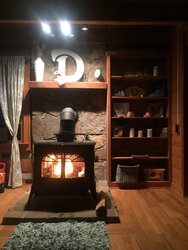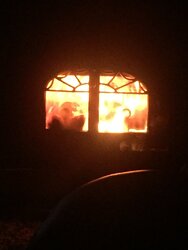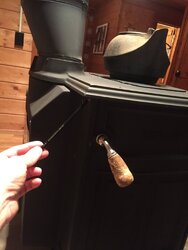so I recently bought a new house and it has a Vermont castings defiant stove in it. I don't know a lot about wood stoves so just hang with me. I read the owners manual I found online for the unit and it said this particular stove has a catalyst that would engage around 425 degrees. It said to leave the flu all the way open until the stove reached 425 and the close the flu all the way. It said there are only two positions that you should have the flu all the way open or all the way closed. So with all that being said, I have been pulling my hair out trying to figure this out. I will get my stove hot with a really good coal bed and the fire will be burning very hot and fast. Then I will want to choke it down and burn slow, so I will do exactly what the manual said and close my flu all the way and then I get smoke coming out of the heater into the house. The only way I can keep smoke from getting in the house is to leave the flu barely cracked but then my fire burns really really fast even with the air cut all the way off to it. I'm just wondering if my catalyst could be stopped up or what could be going on. I'm burning seasoned oak and hickory. I will attach a pic. In the pic the air is all the way closed and the flu is cracked and the fire is burning way to fast. Please give me some ideas to what could be wrong
Vermont casting defiant getting smoke in house
- Thread starter Loghomeguy77
- Start date
-
Active since 1995, Hearth.com is THE place on the internet for free information and advice about wood stoves, pellet stoves and other energy saving equipment.
We strive to provide opinions, articles, discussions and history related to Hearth Products and in a more general sense, energy issues.
We promote the EFFICIENT, RESPONSIBLE, CLEAN and SAFE use of all fuels, whether renewable or fossil.
You are using an out of date browser. It may not display this or other websites correctly.
You should upgrade or use an alternative browser.
You should upgrade or use an alternative browser.
- Status
- Not open for further replies.
1st things first: stove basics.
Check this thread out,it may be helpful.
https://www.hearth.com/talk/threads/vc-encore-2040-how-to-burn.156965/
also, this might be helpful as well
https://www.hearth.com/talk/threads...urning-wood-in-your-stove-a-flowchart.157888/
- lever on the left of the stove when you are looking at it closes the bypass to engage the catalyst. This is the one that only has two positions. With no fire in the stove, open the top and see if this bypass is working. when you pull it forward, it should close the bypass on the top.
- Lever on the right is your air control, which will work with either the bypass open or closed. you should be able to reduce it by about 1/2 and then gradually bring it down to almost nothing, but not all at once. if you drop it too fast, you will suck the air out of the fire, and then it will essentially create a fireball (backpuffing) and can pop open the top and spill smoke. Try doing a test to see if the air control is working and turn the lever on the right towards the back of the stove suddenly to see if it has any effect. if no effect, you probably have something wrong with the air control.
- Catalyst is inside the stove, you want to make sure that it is 1) there, and 2) clean. When there is no fire, remove the backplate, pull out the catalyst, and make sure it is in good condition. no missing pieces, doesn't look like it is abused, and not covered in ash. brush gently and put it back.
- Catalyst Probe/Thermometer should be on the back of the stove. there might be one there, there might not be. if there is one, this will be helpful, if not, getting one will be helpful.
- Also, this sounds silly, but check to make sure that the ash pan door is closed all the way. sometimes it looks like it is, but it isn't and you can overfire really easily without realizing it.
- Where is the smoke coming from, can you tell? if it is coming from the top, then you may have a bad gasket. if it is from the stovepipe, you probably have a bad fit.
- Is the smoke pouring out, or just in burps? pouring most likely means bad seals/gaskets/fit burps=air control most likely
- Are you opening any of the doors or top? if you are, this will cause smoke to puff out.
- Does the condition get better or worse when the temperature changes outside?
Check this thread out,it may be helpful.
https://www.hearth.com/talk/threads/vc-encore-2040-how-to-burn.156965/
also, this might be helpful as well
https://www.hearth.com/talk/threads...urning-wood-in-your-stove-a-flowchart.157888/
Thanks for the reply. The ash pan is closed. The best I can tell the smoke is coming from the where the top of the stove meets the walls at the back. Once I close the flu all the way it pours.
Thanks for the reply. The ash pan is closed. The best I can tell the smoke is coming from the where the top of the stove meets the walls at the back. Once I close the flu all the way it pours.
if you can see where it is coming from and get a picture of it, that might help, but it sort of sounds like you have either a crack in the stove or something is not connected. is it coming out of the stove or the flue connection?
You might also have something blocking your flue above your cat... check that out as well.
husky345 vermont resolute
Feeling the Heat
Personally I would get rid of the Vermont . I had a resolute and was constantly having to do maintenance on it. I decided to go to the drolet classic and am very happy with it
Personally I would get rid of the Vermont . I had a resolute and was constantly having to do maintenance on it. I decided to go to the drolet classic and am very happy with it
it also depends on what model it is and how often you plan to use it. I love my 2040, but it is a newer model.
I just talked to the guy I bought the house from and he said that he had a guy come and and clean it really good and check everything out last year and everything checked out good. Do y'all think something could be wrong with the catalyst?
RandyBoBandy
Minister of Fire
When you say you are closing the "flue" you are talking about the damper (bypass) handle on the left side of the stove correct?
RandyBoBandy
Minister of Fire
What model is your stove? On both of my VC burners the damper is either all the way closed or all the way open. There is no in between. I would pull the fire back out and check for any obstructions. Make sure the cat is good and clean. Just because the guy said it was "cleaned" very good doesn't mean a thing. Best of luck. Let us know what you find.
Regardless of what the previous owner said, that catalyst needs cleaning. That is absolutely the most likely problem, and it's easy to do in your 1910 model. The waffle looking thing at the rear of the firebox will lift up and then forward, exposing the catalytic combustor. Try getting youc vacuum in there WHENYOU'RE SURE THE STOVE IS DEAD COLD and clean it off. Replace the waffle. Done. If that doesn't d it, the refractory assembly may also need cleaning, but probably not. Try it!
zenoparadox
New Member
Yes that is correct
The terminology you have been using is confusing. You are not in fact "closing the flue". Closing the bypass changes the path of the gases but they ultimately do go up the flue, whether it is engaged or not. Some installations have a flue damper that allows closing the flue.
"Closing the bypass" and "engaging the cat" are two expressions that are unambiguous in the context of talking about your kind of stove.
Ok my bad I'm talking about closing the bypass. I left for deer camp yesterday and won't be back to the house until Sunday. I will take it apart and clean it out when I get back and let y'all know how it works I appreciate all the help!
- Status
- Not open for further replies.
Similar threads
- Replies
- 2
- Views
- 480
- Replies
- 14
- Views
- 2K
- Replies
- 8
- Views
- 908
- Replies
- 50
- Views
- 2K
- Replies
- 3
- Views
- 286




